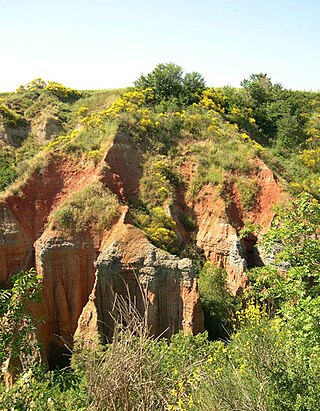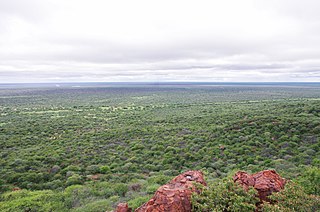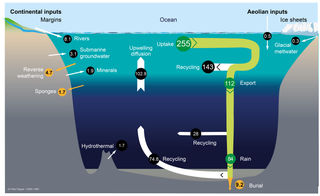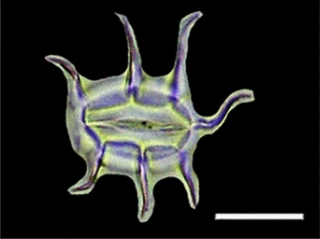
In classical soil science, humus is the dark organic matter in soil that is formed by the decomposition of plant and animal matter. It is a kind of soil organic matter. It is rich in nutrients and retains moisture in the soil. Humus is the Latin word for "earth" or "ground".

Paleoethnobotany, or archaeobotany, is the study of past human-plant interactions through the recovery and analysis of ancient plant remains. Both terms are synonymous, though paleoethnobotany is generally used in North America and acknowledges the contribution that ethnographic studies have made towards our current understanding of ancient plant exploitation practices, while the term archaeobotany is preferred in Europe and emphasizes the discipline's role within archaeology.
Archaeogenetics is the study of ancient DNA using various molecular genetic methods and DNA resources. This form of genetic analysis can be applied to human, animal, and plant specimens. Ancient DNA can be extracted from various fossilized specimens including bones, eggshells, and artificially preserved tissues in human and animal specimens. In plants, ancient DNA can be extracted from seeds and tissue. Archaeogenetics provides us with genetic evidence of ancient population group migrations, domestication events, and plant and animal evolution. The ancient DNA cross referenced with the DNA of relative modern genetic populations allows researchers to run comparison studies that provide a more complete analysis when ancient DNA is compromised.

A microfossil is a fossil that is generally between 0.001 mm and 1 mm in size, the visual study of which requires the use of light or electron microscopy. A fossil which can be studied with the naked eye or low-powered magnification, such as a hand lens, is referred to as a macrofossil.

In the geosciences, paleosol is an ancient soil that formed in the past. The precise definition of the term in geology and paleontology is slightly different from its use in soil science.

Carbon sequestration is the process of storing carbon in a carbon pool. Carbon sequestration is a naturally occurring process but it can also be enhanced or achieved with technology, for example within carbon capture and storage projects. There are two main types of carbon sequestration: geologic and biologic.

Energy crops are low-cost and low-maintenance crops grown solely for renewable bioenergy production. The crops are processed into solid, liquid or gaseous fuels, such as pellets, bioethanol or biogas. The fuels are burned to generate electrical power or heat.

Biochar is the lightweight black residue, made of carbon and ashes, remaining after the pyrolysis of biomass, and is a form of charcoal. Biochar is defined by the International Biochar Initiative as "the solid material obtained from the thermochemical conversion of biomass in an oxygen-limited environment". Biochar is a stable solid that is rich in pyrogenic carbon and can endure in soil for thousands of years.
Post-excavation analysis constitutes processes that are used to study archaeological materials after an excavation is completed. Since the advent of "New Archaeology" in the 1960s, the use of scientific techniques in archaeology has grown in importance. This trend is directly reflected in the increasing application of the scientific method to post-excavation analysis. The first step in post-excavation analysis should be to determine what one is trying to find out and what techniques can be used to provide answers. Techniques chosen will ultimately depend on what type of artifact(s) one wishes to study. This article outlines processes for analyzing different artifact classes and describes popular techniques used to analyze each class of artifact. Keep in mind that archaeologists frequently alter or add techniques in the process of analysis as observations can alter original research questions.
Deborah M. Pearsall is an American archaeologist who specializes in paleoethnobotany. She maintains an online phytolith database. She is a full professor in the Department of Anthropology at the University of Missouri in Columbia, Missouri, where she first began working in 1978. She received her Ph.D. in anthropology from the University of Illinois at Urbana-Champaign in 1979, with a dissertation titled The Application of Ethnobotanical Techniques to the Problem of Subsistence in the Ecuadorian Formative.
Dolores Rita Piperno is an American archaeologist specializing in archaeobotany. She is a senior scientist emeritus of the Smithsonian Tropical Research Institute in Balboa, Panama and the Smithsonian National Museum of Natural History, Washington.

Hatula is an early Neolithic archeological site in the Judean hills south of Latrun, beside Nahshon Stream, in Israel, 20 kilometres (12 mi) west of Jerusalem. The site is 15 metres (49 ft) above the riverbed on a rocky slope in an alluvial valley. Excavations revealed three levels of occupation in the Natufian, Khiamian and PPNA (Sultanian).

Holistic Management in agriculture is an approach to managing resources that was originally developed by Allan Savory for grazing management. Holistic Management has been likened to "a permaculture approach to rangeland management". Holistic Management is a registered trademark of Holistic Management International.

Regenerative agriculture is a conservation and rehabilitation approach to food and farming systems. It focuses on topsoil regeneration, increasing biodiversity, improving the water cycle, enhancing ecosystem services, supporting biosequestration, increasing resilience to climate change, and strengthening the health and vitality of farm soil.

Woody plant encroachment is a natural phenomenon characterised by the increase in density of woody plants, bushes and shrubs, at the expense of the herbaceous layer, grasses and forbs. It predominantly occurs in grasslands, savannas and woodlands and can cause biome shifts from open grasslands and savannas to closed woodlands. The term bush encroachment refers to the expansion of native plants and not the spread of alien invasive species. It is thus defined by plant density, not species. Bush encroachment is often considered an ecological regime shift and can be a symptom of land degradation. The phenomenon is observed across different ecosystems and with different characteristics and intensities globally.

Carbon farming is a name for a variety of agricultural methods aimed at sequestering atmospheric carbon into the soil and in crop roots, wood and leaves. The aim of carbon farming is to increase the rate at which carbon is sequestered into soil and plant material with the goal of creating a net loss of carbon from the atmosphere. Increasing a soil's organic matter content can aid plant growth, increase total carbon content, improve soil water retention capacity and reduce fertilizer use. Carbon farming is one component of climate-smart agriculture.

The silica cycle is the biogeochemical cycle in which biogenic silica is transported between the Earth's systems. Silicon is considered a bioessential element and is one of the most abundant elements on Earth. The silica cycle has significant overlap with the carbon cycle and plays an important role in the sequestration of carbon through continental weathering, biogenic export and burial as oozes on geologic timescales.
The soil matrix is the solid phase of soils, and comprise the solid particles that make up soils. Soil particles can be classified by their chemical composition (mineralogy) as well as their size. The particle size distribution of a soil, its texture, determines many of the properties of that soil, in particular hydraulic conductivity and water potential, but the mineralogy of those particles can strongly modify those properties. The mineralogy of the finest soil particles, clay, is especially important.
Caroline A. E. Strömberg is a Swedish-American paleontologist whose primary research focuses on the deep time evolution and ecology of plants through the use of the fossil record and by comparison with modern analogues, more specifically how previous plant communities changed in response to climate change and how plant evolution affected animal evolution. She is currently the Estella B. Leopold Professor of Biology and an adjunct associate professor in Earth and Space Sciences at the University of Washington and the Curator of Paleobotany at the affiliated Burke Museum of Natural History and Culture.
Isotope analysis has many applications in archaeology, from dating sites and artefacts, determination of past diets and migration patterns and for environmental reconstruction.




















